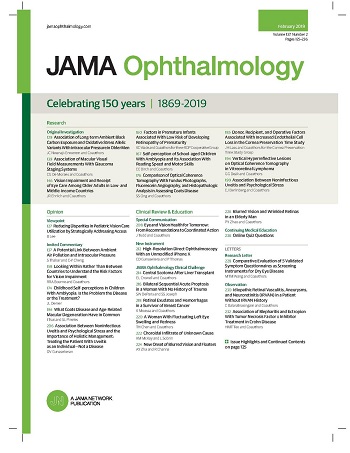Ocular Adverse Events With Semaglutide: A Systematic Review and Meta-Analysis.
IF 9.2
1区 医学
Q1 OPHTHALMOLOGY
引用次数: 0
Abstract
Importance Semaglutide is a widely used treatment for diabetes and obesity, offering considerable cardiovascular benefit. However, its association with ocular adverse events remains uncertain. Objective To assess the incidence of eye disorders, diabetic retinopathy, and nonarteritic anterior ischemic optic neuropathy (NAION) in adults treated with semaglutide. Data Sources A comprehensive electronic search of PubMed, Embase, and the Cochrane Central Register of Controlled Trials was conducted on April 10, 2025, without date restrictions. Study Selection Investigators independently screened records to identify randomized clinical trials comparing semaglutide with either an active comparator or placebo in adults, assessing ocular adverse events. Data Extraction and Synthesis Descriptive synthesis of the included studies was performed. The random-effects model using the inverse variance method was used to summarize the odds ratio (OR) for eye disorders and diabetic retinopathy. Peto OR with a fixed-effects model was applied for NAION. Risk of bias was assessed with the RoB 2.0 tool and quality of evidence with GRADE. Trial sequential analysis (TSA) was performed to determine whether the available data were sufficient for definitive conclusions. Main Outcomes and Measures The primary outcomes included the number of patients experiencing an ocular adverse event, diabetic retinopathy, or NAION. Subgroup analyses were conducted based on follow-up duration, comparator type, and primary baseline condition. Results A total of 78 trials with 73 640 participants were included. Semaglutide did not increase or reduce the risk of eye disorders (OR, 1.01; 95% CI, 0.91-1.12) or diabetic retinopathy (OR, 1.04; 95% CI, 0.92-1.17). Treatment with semaglutide was associated with a significant odds of NAION (OR, 3.92; 95% CI, 1.02-15.02). Overall risk of bias was low. TSA provided evidence that the sample size was sufficient to avoid missing alternative results for diabetic retinopathy but not for NAION. Conclusions and Relevance These findings suggest that semaglutide was not associated with an increased risk of eye disorders or diabetic retinopathy. Despite the fact that an association between semaglutide treatment and NAION was found, current evidence remains insufficient to establish definitive conclusions regarding its association with NAION. Further studies with larger sample sizes and adequate evaluation of NAION are warranted to clarify this potential risk.西马鲁肽的眼部不良事件:系统回顾和荟萃分析。
重要性:马格鲁肽是一种广泛用于治疗糖尿病和肥胖症的药物,具有相当大的心血管益处。然而,其与眼部不良事件的关系仍不确定。目的评估使用西马鲁肽治疗的成人眼病、糖尿病视网膜病变和非动脉性前缺血性视神经病变(NAION)的发生率。数据来源于2025年4月10日对PubMed、Embase和Cochrane中央对照试验登记册进行了全面的电子检索,没有日期限制。研究选择研究人员独立筛选记录,以确定在成人中比较semaglutide与活性比较物或安慰剂的随机临床试验,评估眼部不良事件。数据提取和综合对纳入的研究进行描述性综合。采用反方差法的随机效应模型对眼病与糖尿病视网膜病变的比值比(OR)进行总结。采用固定效应模型的Peto OR模型。偏倚风险用RoB 2.0工具评估,证据质量用GRADE评估。进行试验序贯分析(TSA)以确定现有数据是否足以得出明确结论。主要结局和测量主要结局包括发生眼部不良事件、糖尿病视网膜病变或NAION的患者数量。根据随访时间、比较者类型和主要基线情况进行亚组分析。结果共纳入78项试验,73 640名受试者。Semaglutide不会增加或降低眼部疾病的风险(or, 1.01;95% CI, 0.91-1.12)或糖尿病视网膜病变(or, 1.04;95% ci, 0.92-1.17)。使用西马鲁肽治疗与发生NAION的显著几率相关(OR, 3.92;95% ci, 1.02-15.02)。总体偏倚风险较低。TSA提供的证据表明,样本量足以避免遗漏糖尿病视网膜病变的替代结果,但不能避免遗漏NAION。结论和相关性这些发现表明,西马鲁肽与眼部疾病或糖尿病视网膜病变的风险增加无关。尽管发现了西马鲁肽治疗与NAION之间的关联,但目前的证据仍不足以就其与NAION的关联建立明确的结论。有必要进行更大样本量的进一步研究,并对NAION进行充分评估,以阐明这一潜在风险。
本文章由计算机程序翻译,如有差异,请以英文原文为准。
求助全文
约1分钟内获得全文
求助全文
来源期刊

JAMA ophthalmology
OPHTHALMOLOGY-
CiteScore
13.20
自引率
3.70%
发文量
340
期刊介绍:
JAMA Ophthalmology, with a rich history of continuous publication since 1869, stands as a distinguished international, peer-reviewed journal dedicated to ophthalmology and visual science. In 2019, the journal proudly commemorated 150 years of uninterrupted service to the field. As a member of the esteemed JAMA Network, a consortium renowned for its peer-reviewed general medical and specialty publications, JAMA Ophthalmology upholds the highest standards of excellence in disseminating cutting-edge research and insights. Join us in celebrating our legacy and advancing the frontiers of ophthalmology and visual science.
 求助内容:
求助内容: 应助结果提醒方式:
应助结果提醒方式:


